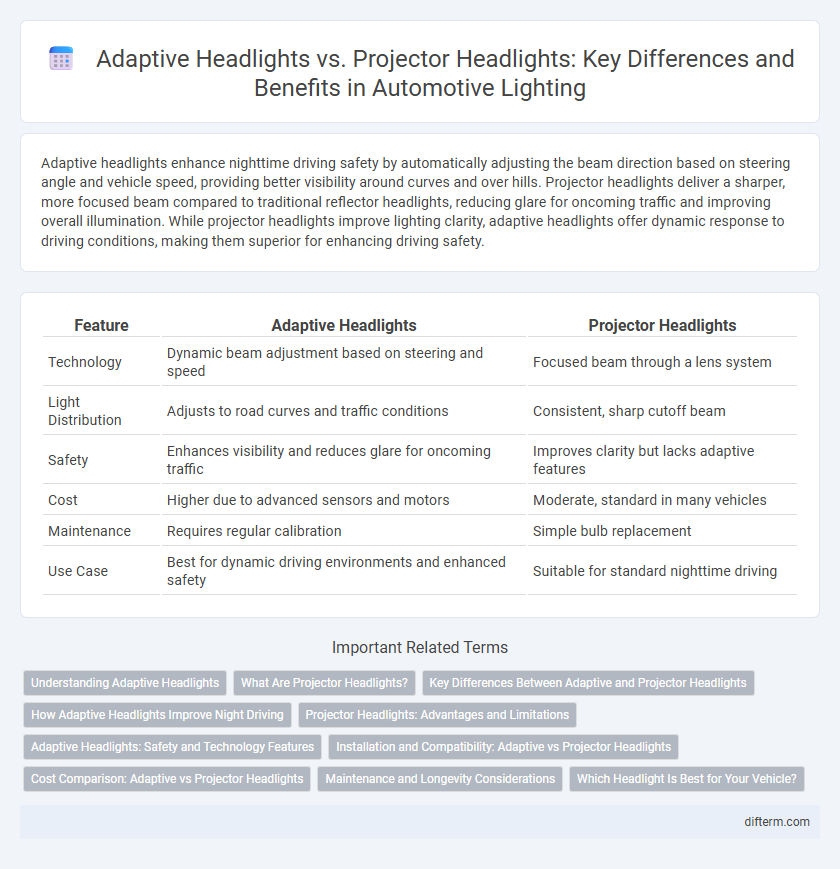Adaptive headlights enhance nighttime driving safety by automatically adjusting the beam direction based on steering angle and vehicle speed, providing better visibility around curves and over hills. Projector headlights deliver a sharper, more focused beam compared to traditional reflector headlights, reducing glare for oncoming traffic and improving overall illumination. While projector headlights improve lighting clarity, adaptive headlights offer dynamic response to driving conditions, making them superior for enhancing driving safety.
Table of Comparison
| Feature | Adaptive Headlights | Projector Headlights |
|---|---|---|
| Technology | Dynamic beam adjustment based on steering and speed | Focused beam through a lens system |
| Light Distribution | Adjusts to road curves and traffic conditions | Consistent, sharp cutoff beam |
| Safety | Enhances visibility and reduces glare for oncoming traffic | Improves clarity but lacks adaptive features |
| Cost | Higher due to advanced sensors and motors | Moderate, standard in many vehicles |
| Maintenance | Requires regular calibration | Simple bulb replacement |
| Use Case | Best for dynamic driving environments and enhanced safety | Suitable for standard nighttime driving |
Understanding Adaptive Headlights
Adaptive headlights use sensors and motorized mechanisms to adjust the direction and intensity of light based on driving conditions, improving visibility around curves and during turns. Unlike projector headlights that rely on a fixed light source and lens to focus the beam, adaptive headlights dynamically respond to steering angle, vehicle speed, and ambient lighting. This technology enhances safety by reducing glare for oncoming traffic while maximizing illumination on the road ahead.
What Are Projector Headlights?
Projector headlights use a compact, lens-focused design that produces a sharp, concentrated beam of light for improved road illumination and reduced glare. Unlike traditional reflector headlights, they employ a bulb positioned behind a reflector and a convex lens that directs the light precisely, enhancing visibility and safety during nighttime driving. Commonly found in modern vehicles, projector headlights support various light sources, including halogen, HID, and LED, making them versatile and efficient lighting solutions.
Key Differences Between Adaptive and Projector Headlights
Adaptive headlights dynamically adjust the direction and intensity of the light beam based on vehicle speed, steering angle, and road conditions to enhance visibility and safety during turns and varying driving environments. Projector headlights use a fixed lens system to focus and project a sharper, more concentrated beam of light, providing improved brightness and precision compared to traditional reflector headlights. The key difference lies in adaptability, with adaptive headlights offering real-time responsiveness, while projector headlights primarily improve light focus without changing beam direction.
How Adaptive Headlights Improve Night Driving
Adaptive headlights enhance night driving by automatically adjusting the beam direction based on steering angle, vehicle speed, and road conditions, improving visibility around curves and over hills. Unlike projector headlights, which focus light into a fixed, sharp beam for better clarity, adaptive headlights dynamically respond to real-time driving scenarios, reducing glare for oncoming traffic and increasing safety. This technology ensures optimal illumination, helping drivers detect obstacles, pedestrians, and road signs earlier during nighttime driving.
Projector Headlights: Advantages and Limitations
Projector headlights deliver focused, brighter beams using a lens to shape light, enhancing nighttime visibility and reducing glare for oncoming traffic. Their compact design allows for stylish, modern headlight assemblies that improve a vehicle's aesthetic appeal. However, projector headlights may have limitations in terms of heat dissipation and higher manufacturing costs compared to traditional reflector headlights.
Adaptive Headlights: Safety and Technology Features
Adaptive headlights enhance driving safety by dynamically adjusting beam direction and intensity based on vehicle speed, steering angle, and road conditions, significantly improving visibility on curves and during lane changes. This advanced technology incorporates sensors and cameras to detect oncoming traffic, reducing glare and enhancing driver awareness in various environments. Unlike traditional projector headlights, adaptive systems offer a smarter, responsive lighting solution that adapts in real-time for optimal illumination and accident prevention.
Installation and Compatibility: Adaptive vs Projector Headlights
Adaptive headlights require advanced sensors and control modules for installation, making the process more complex and often limited to compatible vehicle models with integrated electronic systems. Projector headlights feature a simpler installation, as they primarily involve replacing existing assemblies without extensive wiring or programming, offering broader compatibility across various vehicle makes and models. Choosing between adaptive and projector headlights depends on the vehicle's existing electrical architecture and the feasibility of integrating adaptive headlight components.
Cost Comparison: Adaptive vs Projector Headlights
Adaptive headlights generally come with a higher price tag due to advanced sensors and motorized components that adjust beam direction based on driving conditions, costing between $1,000 to $2,500 per set. Projector headlights, utilizing a fixed lens to focus light more efficiently than traditional reflector headlights, typically range from $300 to $700 per set, making them a more budget-friendly option. Maintenance costs also differ: adaptive headlights may incur additional expenses for sensor calibration and motor repairs, whereas projector headlights usually require simpler bulb replacements.
Maintenance and Longevity Considerations
Adaptive headlights incorporate advanced sensors and moving parts that may require more frequent calibration and maintenance compared to projector headlights, which have a simpler design with fixed lenses. Projector headlights typically offer longer durability due to their sealed housing that protects against moisture and debris, reducing wear and the need for repairs. Choosing between the two depends on balancing the enhanced visibility and safety features of adaptive headlights against the lower maintenance demands and extended lifespan of projector headlights.
Which Headlight Is Best for Your Vehicle?
Adaptive headlights enhance nighttime driving safety by automatically adjusting the beam direction based on steering angle and speed, improving visibility on curves and hills. Projector headlights deliver a focused, intense light beam with sharp cutoffs, reducing glare for oncoming traffic and providing a modern aesthetic. Choosing the best headlight depends on your driving environment: adaptive headlights are ideal for active, varied road conditions, while projector headlights suit drivers seeking precise light control and stylish design.
Adaptive headlights vs Projector headlights Infographic

 difterm.com
difterm.com